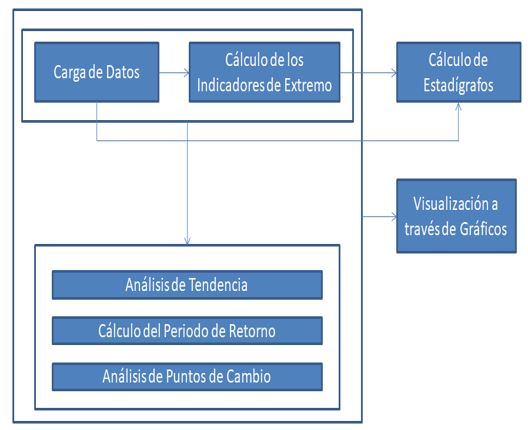ICCE: Software to calculate extreme clime change indicators
Main Article Content
Abstract
Due to the constant difficulties that clime change has in daily living, it is necessary to create tools that provide a detailed study of the effects of these changes. The most important need is to establish a common ground to study clime change. The use of clime change indicators is one of the directions to achieve this common ground. These indicators show the behavior of what is considered by the experts as the major effects of clime change. Although, indicators on itself do not provide enough information since more often than not they constitute high volumes of data. To facilitate the study and comprehension of the indicators, a software was developed to automatize the part of the process of study of the indicators. The tools provided are, trend analysis and point of change trough non-parametric tests such as Kendall-Mann and Pettitt tests and the analysis of the return periods through the extreme values theory more specifically the generalized extreme values distribution. It is described a methodology focused on the use of these tools that will accommodate the work of the Institute of Meteorology experts.
Downloads
Article Details

This work is licensed under a Creative Commons Attribution-NonCommercial 4.0 International License.
Those authors who have publications with this journal accept the following terms of the License Attribution-NonCommercial 4.0 International (CC BY-NC 4.0):
You are free to:
- Share — copy and redistribute the material in any medium or format
- Adapt — remix, transform, and build upon the material
The licensor cannot revoke these freedoms as long as you follow the license terms.
Under the following terms:
- Attribution — You must give appropriate credit, provide a link to the license, and indicate if changes were made. You may do so in any reasonable manner, but not in any way that suggests the licensor endorses you or your use.
- NonCommercial — You may not use the material for commercial purposes.
- No additional restrictions — You may not apply legal terms or technological measures that legally restrict others from doing anything the license permits.
The journal is not responsible for the opinions and concepts expressed in the works, they are the sole responsibility of the authors. The Editor, with the assistance of the Editorial Committee, reserves the right to suggest or request advisable or necessary modifications. They are accepted to publish original scientific papers, research results of interest that have not been published or sent to another journal for the same purpose.
The mention of trademarks of equipment, instruments or specific materials is for identification purposes, and there is no promotional commitment in relation to them, neither by the authors nor by the publisher.
References
Burgos, Y., y González, I. (2012). Análisis de indicadores de extremos climáticos en la isla de Cuba.
Busababodhin, P., Seo, Y.A., Park, J.S., y Kumphon, B. (2015). LH-moment estimation of Wakeby distribution with hydrological applications.
Coles, S. (2001). An Introduction to Statistical Modeling of Extreme Values.
Cooley, D. (2011). Return Periods and Return Levels Under Climate Change.
IPCC. (2007). Cambio climático 2007. Contribución de los Grupos de trabajo I, II y III al Cuarto Informe de evaluación del Grupo Intergubernamental de Expertos sobre el Cambio Climático. Informe de síntesis. Ginebra, Suiza. IPCC: ISBN 92-9169-322-7.
IPCC. (2014). Climate Change 2014. Contribución de los Grupos de trabajo I, II y III al Quinto Informe de evaluación del Grupo Intergubernamental de Expertos sobre el Cambio Climático. Informe de síntesis. Ginebra, Suiza.
Medialdea, A. (2016). Análisis de Valores Extremos -Modelización Espacial.
Pettitt, A.N. (1978). A Non-parametric Approach to the Change-point Problem.
Pohlert, T. (2020). Non-Parametric Trend Tests and Change-Point Detection.
Roura, P., Sistachs V., Rodríguez, J.A., y Vega, R. (2019). SEVECLIM: Software para Analizar Modelos Probabilísticos para Caracterizar Variables Climáticas Extremas. Revista Investigación Operacional.
Roura, P., Sistachs, V., y Arenas, J.C. (2019). TrendSoft: Software para el análisis de tendencia y puntos de cambios de variables climatológicas.
Ruíz, O., Espejel, D., Ontiveros, R.E., Enciso, J.M., Galindo, M. A., Quesada, M. L., Grageda, J., Ramos, R., y Ruíz, J.A. (2016). Tendencia de temperaturas máximas y mínimas mensuales en Aguascalientes, México. Revista Mexicana de Ciencias Agrícolas, Instituto Nacional de Investigaciones Forestales, Agrícolas y Pecuarias, Estado de México, México.
Sneyers, R. (1990). On the statistics analysis of series of observations. LA nota técnica 143.
Wang, Q. J. (1997). LH moments for statistical analysis of extreme events.

